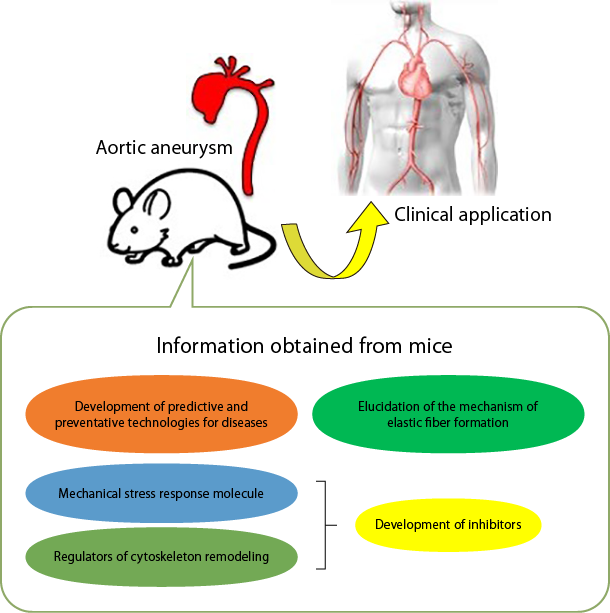EFFORTS OF UNIVERSITY OF TSUKUBAEfforts of University of Tsukuba

Investigation of the Molecular Mechanism of Aortic Aneurysms and Identification of Target Molecules for New Therapy
An aortic aneurysm is a malady in which the wall of the blood vessel dilates abnormally, leading to rupture, and eventually, death. Because the underlying mechanisms for this disease is not known, there is no effective drug therapies. Therefore, to clarify the molecular mechanisms of aortic aneurysm and to develop prevention and treatment strategies are an urgent task.
 We have previously found that deficiency in fibulin-4, an extracellular matrix protein that controls vascular elasticity (the ability of expanded blood vessels to contract), induces aortic aneurysms (Huang et al. Circ. Res., 2010). Additionally, we found various pathological changes, including arterial wall thickening, elastic fiber disruption, vascular smooth muscle proliferation and local increase in renin-angiotensin signals at aortic aneurysm lesions (Huang et al. Sci. Transl. Med., 2013). Furthermore, by combining proteomic analysis, which is a comprehensive examination of protein expression, with biochemical and histological approaches, we identified that activation of the slingshot-cofilin pathway may be a new target molecule for aortic aneurysm therapy (Yamashiro et al. Sci. Signal., 2015).
We have previously found that deficiency in fibulin-4, an extracellular matrix protein that controls vascular elasticity (the ability of expanded blood vessels to contract), induces aortic aneurysms (Huang et al. Circ. Res., 2010). Additionally, we found various pathological changes, including arterial wall thickening, elastic fiber disruption, vascular smooth muscle proliferation and local increase in renin-angiotensin signals at aortic aneurysm lesions (Huang et al. Sci. Transl. Med., 2013). Furthermore, by combining proteomic analysis, which is a comprehensive examination of protein expression, with biochemical and histological approaches, we identified that activation of the slingshot-cofilin pathway may be a new target molecule for aortic aneurysm therapy (Yamashiro et al. Sci. Signal., 2015).
Our study identified the signaling pathways involved in aortic aneurysm progression. We expect to develop new targets for drug discovery. Moving forward, we will develop inhibitors of these molecules, clarify the relationship between elastic fiber formation and vascular wall maintenance, with the goal of clinical application.
University of Tsukuba PR (featured research)
http://www.tsukuba.ac.jp/attention-research/p201510210300.html
QLife Pro medical news
http://www.qlifepro.com/news/20151023/identify-the-signaling-pathways-involved-in-the-formation-of-aortic-aneurysm.html
Santen Medical Channel
https://www.santen.co.jp/medical-channel/op/medicalnews/2015/1023-identify-the-signaling-pathways-involved-in-the-formation-of-aortic-aneurysm.html
Professor, Life Science Center for Survival Dynamics
Assistant Professor, Life Science Center for Survival Dynamics
Professor, Cardiovascular Surgery, Faculty of Medicine
NAGAYAMA Kazuaki
Professor, College of Engineering, Ibaraki University
NAKAMURA Tomoyuki
Professor, Pharmacology, Kansai Medical University




